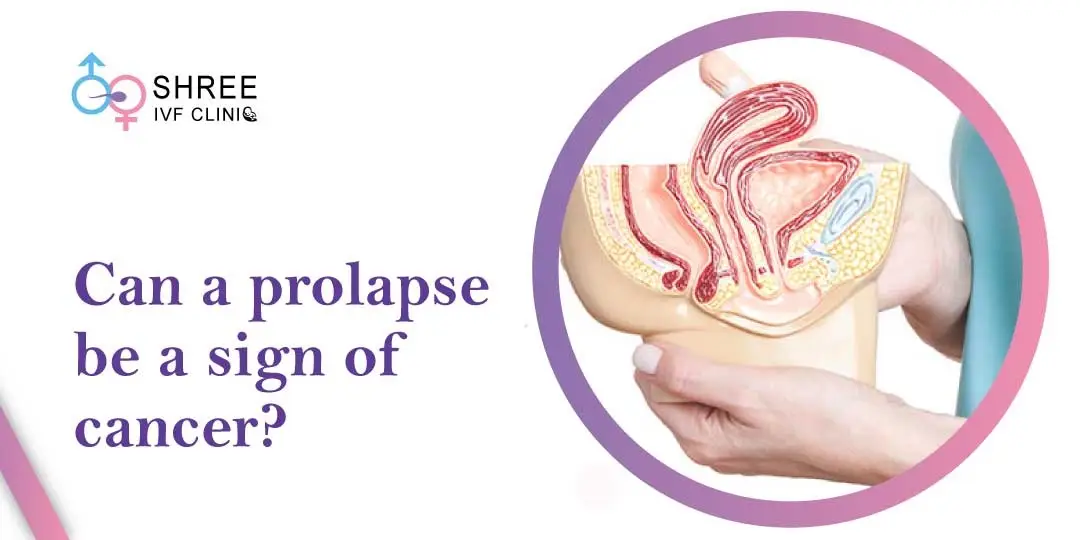Why Does Uterine Prolapse Cause Bleeding?
UPDATED ON 9TH MAR. 2024
Living with a female body, we must be attuned to its intricacies and potential health issues. Uterine prolapse is one such complex condition that can have significant impacts on a woman’s life, including causing bleeding.
If you’ve been experiencing unusual bleeding and have been diagnosed with uterine prolapse, understanding the correlation between these symptoms is crucial. In this in-depth exploration, we’ll dissect why uterine prolapse can result in bleeding, the various types associated with this condition, and, most importantly, the steps you can take to address the issue.

AUTHOR
Dr Jay Mehta
Scientific Director & IVF Specialist with 10+ years of experience
CONDITION
GET IN TOUCH ON
Understanding Uterine Prolapse
Before we tackle the bleeding aspect, we must grasp what uterine prolapse is. Uterine prolapse occurs when the uterus descends into the vagina due to weakened muscles and ligaments that usually support it.
This displacement can range from mild to severe, with symptoms including a feeling of heaviness in the pelvic region, backache, urinary difficulties, and, of course, abnormal bleeding. But why does this descent result in bleeding?
Causes of Uterine Prolapse
One of the leading causes of uterine prolapse is weakened pelvic floor muscles and connective tissues, a condition that becomes more common with age and following childbirth.
Other risk factors include prior pelvic surgery, a family history of prolapse, chronic cough, or obesity. As the uterus shifts from its normal position, it can put pressure on surrounding structures, leading to complications such as bleeding.
Bleeding and Uterine Prolapse: A Deep Dive
Bleeding experienced with uterine prolapse can take several forms, each potentially indicative of different underlying issues.
Types of Bleeding Associated with Uterine Prolapse
The most common form of bleeding related to uterine prolapse is abnormal vaginal bleeding (menometrorrhagia) which involves either heavy periods or bleeding between periods.
This can be explained by the fact that the prolapsed uterus is closer to the entrance of the vagina, making it more susceptible to trauma during physical activities, sex, or even just walking.
Another type is postmenopausal bleeding (if the woman is past menopause). This is considered more severe and should prompt immediate medical attention as it could be a sign of cancer, mainly when associated with uterine prolapse.
Impact on Women’s Health
Abnormal bleeding can significantly impact a woman’s quality of life. It often leads to anemia and fatigue and, in severe cases, can necessitate blood transfusions. The mental and emotional burden of dealing with unpredictable bleeding episodes can also be quite distressing.
Bleeding associated with uterine prolapse should never be ignored. While not every case is an emergency, it’s always worth investigating the causes for peace of mind and appropriate treatment.
Diagnosing Uterine Prolapse and Bleeding
Identifying uterine prolapse and its link to bleeding often involves a combination of symptom recognition and medical tests.
Common Signs Indicating Uterine Prolapse
One of the earliest signs of uterine prolapse is a feeling of heaviness or dragging in the pelvis. Women may also notice a bulge or sense something ‘coming down’ in the vaginal area.
Other symptoms can include discomfort during sexual intercourse, lower back pain, and urinary problems such as incontinence or urinary frequency. While these signs can suggest uterine prolapse, a definitive diagnosis typically requires a pelvic examination by a healthcare professional.
Diagnostic Procedures and Tests
To accurately diagnose uterine prolapse and associated bleeding, healthcare professionals may recommend a range of diagnostic procedures and tests:
- Pelvic Examination: A thorough pelvic exam is a primary method for diagnosing uterine prolapse. The doctor will check for structural anomalies and assess the prolapse stage during the exam.
- Ultrasound: An ultrasound might be used to get a clearer view of the pelvic organs and identify any other conditions contributing to the symptoms, such as fibroids or polyps.
- Urodynamic Studies: These studies are performed to evaluate urinary incontinence, which can be a symptom of uterine prolapse. It helps to measure bladder pressure and function.
- MRI: In some cases, Magnetic Resonance Imaging (MRI) can provide detailed images of the pelvic region, aiding in diagnosing more complex cases.
- Pap Smear: While not a diagnosing tool for prolapse, a Pap smear test may be conducted to rule out any presence of cervical or endometrial abnormalities that might cause bleeding.
Early diagnosis and treatment of uterine prolapse and its associated symptoms are essential for improving the patient’s quality of life and mitigating potential complications.
Available Treatment For Uterine Prolapse
The course of treatment for uterine prolapse will depend on the severity of the condition and the preference of the patient.
Non-surgical Treatments
Non-surgical treatments for uterine prolapse are often the first line of defense, particularly for those with mild to moderate prolapse.
- Pelvic floor exercises, also known as Kegel exercises, can strengthen the muscles under the uterus, bladder, and bowel (large intestine).
- Women may also be fitted with a pessary, a device inserted into the vagina that holds the uterus in place.
- Estrogen replacement therapy is another option, principally if the prolapse is due to postmenopausal estrogen loss.
- Lifestyle changes, such as weight management and avoiding heavy lifting, can help alleviate symptoms.
While non-surgical treatments may not be a permanent solution, they can significantly reduce symptoms and improve the quality of life.
Surgical Procedures
In instances where non-surgical methods are unsuccessful or inappropriate, several surgical procedures can be considered to correct uterine prolapse. Surgical interventions are typically more common for severe cases or when the symptoms significantly affect the patient’s quality of life.
Hysterectomy
The most definitive surgery for uterine prolapse is a hysterectomy, which involves the removal of the uterus. This procedure eliminates the possibility of future prolapse; however, it is only recommended for women who are not planning to have children.
Pelvic Floor Repair
For women who wish to retain their uterus or are considering future pregnancies, pelvic floor repair may be an option. This surgery aims to strengthen and reconstruct the pelvic floor muscles and ligaments, supporting the uterus.
Sacrocolpopexy
Sacrocolpopexy is another surgical alternative where a mesh is used to lift and secure the prolapsed pelvic organs. The mesh is attached to the lower backbone (sacrum), ensuring long-term support.
The choice of the procedure largely depends on individual patient factors and the recommendation of the consulting gynecologist in Mumbai, who will consider the effectiveness, potential risks, and personal circumstances when advising on treatment.

4,790+
379K+
finding the right solutions tailored to their specific
circumstances can make all the difference “
Preventive Measures and Lifestyle Changes
Whether you’re taking proactive steps or post-treatment care, there are lifestyle changes that can help prevent or manage uterine prolapse and its complications, including bleeding.
Tips to Reduce the Risk of Uterine Prolapse
Regular pelvic floor exercises, such as Kegel exercises, can significantly strengthen the pelvic muscles and ligaments, reducing the risk of prolapse.
Maintaining a healthy weight through a balanced diet and regular physical activity can alleviate pressure on pelvic structures.
Avoiding heavy lifting and treating constipation promptly is also advisable, as straining can exacerbate the condition.
Lastly, women who smoke should consider quitting, as smoking can lead to chronic coughing, which may contribute to the development of uterine prolapse.
Lifestyle Modifications for Managing Symptoms
For individuals living with symptoms of uterine prolapse, certain adjustments in daily activities can offer relief and impede the progression of the condition.
Implementing postural corrections can reduce the strain on the pelvic floor–standing straight and using proper lifting techniques are vital. When seated for extended periods, taking regular breaks to walk around can also be beneficial.
Utilizing stress reduction strategies such as mindfulness or yoga may not only improve overall well-being but also help in managing the symptoms associated with pelvic floor disorders.
Consulting Gynecologist For Treatment
Ultimately, the key takeaway is that bleeding with uterine prolapse is a serious concern requiring professional evaluation. If you have been diagnosed with uterine prolapse and are experiencing any form of abnormal bleeding, do not hesitate to reach out to your gynecologist. They can help you understand the underlying causes, mitigate the bleeding, and choose the most appropriate treatment plan.
By understanding the mechanisms behind bleeding and uterine prolapse, you’re better positioned to make informed decisions about your health. Empower yourself with knowledge and take an active role in managing your well-being. Remember, your reproductive health is an integral part of your overall health, and it deserves the care and attention needed to maintain a happy, fulfilling life.
AUTHOR
Dr Jay Mehta
Scientific Director & IVF Specialist with 10+ years of experience
TREATMENT
CONDITION
CALL US 24/7 FOR ANY HELP
GET IN TOUCH ON
Share Article on
Related Readings
How is a Bleeding Prolapse Treated?
Epithelial, Germ Cell, and Stromal are ovarian cancer types which are classified by their originating cells
Can Pelvic Organ Prolapse Go Away On Its Own?
Uncover the potential for pelvic organ prolapse (POP) to resolve naturally. Explore symptoms, management options, and factors influencing resolution.
Can Pelvic Organ Prolapse be a Sign of Cancer?
Pelvic Organ Prolapse (POP) doesn’t directly cause cancer, but women with this condition are at a higher risk of developing certain cancers like uterine & gallbladder cancers




